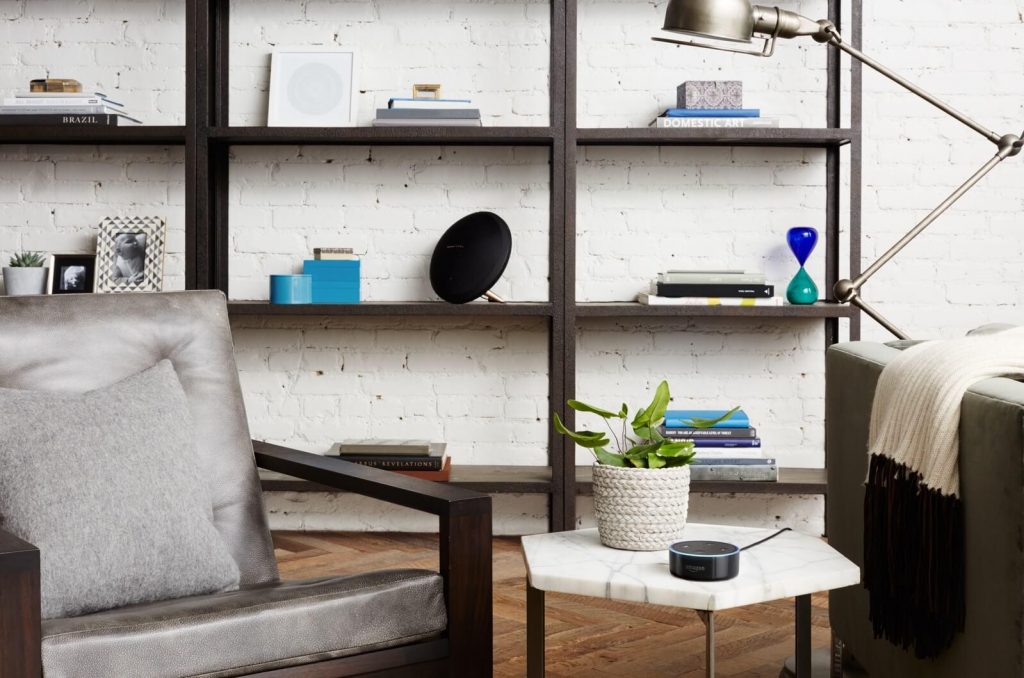A few years ago, it was still slightly irritating to hear people formulating text messages or search queries out loud in the direction of their smartphone. In the meantime, 28.3 million Germans are talking to their smartphone, which has since become the trailblazer of the smart speakers of Amazon, Google and Co.
Here we give you a brief overview of which smart systems are already available and what they do.
Alexa, play my favorite song from Spotify!
In 2012 Amazon had already launched the first test models of its Echo, establishing a strong advantage over its competitors. Designed as a loudspeaker, Amazon’s Echo is now available in two versions in Germany, along with various accessories such as a camera or a tablet.
15,000 applications, so-called skills, have already been designed inhouse as well as by external companies and developers. These include many smart-home functions, various services, such as delivery and taxi-services, as well as games and media streams.
With the aid of the skills, the user can have Alexa read messages and content from the Web, play music and audiobooks from their own Amazon account or from third parties such as Spotify, and control connected home appliances. With the integration of the shopping platform, even ordering the groceries is possible with the assistant.
Alexa gets to know the individual user better every day and with each query, thus improving the quality of the answers and pronunciation. The lack of advertising opportunity may be a disadvantage for companies.
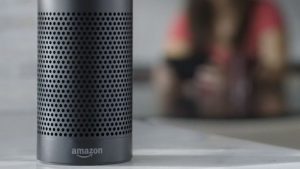
Google Home: The whole web on request
Not to be outdone, Google followed in 2016 with its Google Home speaker, which is expected to be available this summer in Germany. Some functions are also provided here, 378 so far – in this case they are called Actions – which have also been released for external developers. Despite the few functions, the great advantage of Google is its integrated Google search, the calendar, Google Maps and YouTube, which offer an almost infinite source of information, providing more accurate answers than Alexa. Unlike Amazon, Google is also testing the integration of advertising. For example, a filmstart was recently announced in the personal daily summary for some listeners.
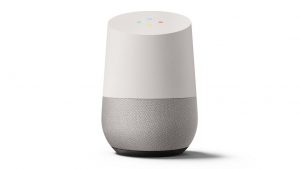
Microsoft Undercover
Clearly, Microsoft’s pendant to Amazon’s Echo should not be missing. The Invoke, however, was developed by Harman Kardon company and uses the voice and intelligence of Microsoft’s Cortana. This was already integrated into Windows 8 and thus accesses a now well-fed data set.
The speaker, which looks very much like the Echo, should be available this Autumn in the USA. Like Google and Amazon, Cortana also uses in-house programs and data. Invoke will have access to Microsoft Office, Bing and Skype and data from the user’s cloud can be called up. Opening up for third-party providers is also planned, in order to expand the (currently only 65) available skills.
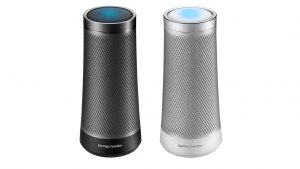
Apple’s designer speakers
One player’s presence was previously missed in the battle of the speakers. Now Apple, too, with its HomePod and Siri is set to start in December. As usual with Apple, it is mostly still hush hush. The focus, however, unlike Amazon or Google, will be on high quality sound when playing music: the HomePod comes with the technology to scan the room for optimal sound reproduction. Other functions, such as the reading of messages, weather reports, and a timer, are also to be included.
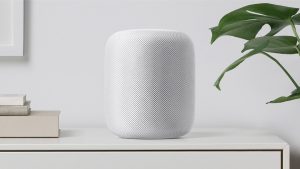
Improved usability; New behavior?
With digital voice-activation, all speakers promise to improve home comfort and make running a household more efficient. The user can deal with tasks simultaneously and faster.
Interestingly, studies have shown that users always give certain commands at the same or similar times of day, thus creating a digital routine. At the same time, new daily rituals emerge and the approach to handling other appliances changes as does communication with family members and partners.
However, the use of devices such as smartphones and tablets remains unchanged to-date, since many functions still require a screen, or this is preferred by the users.
PressMatrix Insider insights
Our UI & UX Designer Daniel, Business Development Manager Andreas and Head of Client Development Tobias have not let the new speakers escape their attention. They talk about their experiences:
1) How many Amazon Ecos or Echo Dots do you have?
Andreas: I have an Amazon Echo Dot, which is placed centrally in the living room.
Daniel: I also have an Echo Dot.
Tobias: I’ve got an Echo Dot at home, which is used in the living room.
2) Have you connected other devices to your Amazon Echo, and if so, which ones?
Andreas: My Echo Dot is connected to a Netatmo weather station as well as to my Philips Hue. With the Amazon Echo, I can output weather data via the voice interface and also selectively control the brightness and light colour of two light-sources in our living.
Daniel: I have two each of Yeelight LEDs, Yeelight Light Bulb Color and TP-LINK Smart sockets to control and regulate the light.
Tobias: I have a Broadlink RM Pro connected to my Echo using the accompanying app, which allows me to use infrared signals. It means that theoretically I can control all devices possessing an infrared remote control via my Echo. At the moment this applies to three radio sockets, each of which controls one of my lamps, my TV, and my music system. The music system is connected to the Echo via Bluetooth.
3) Which functions of your Amazon Echo do you use most frequently?
Daniel: I mostly use Echo for the TV and also for switching on or dimming the light and LEDS to create the right atmospheric effect. When cooking, I often use it to set a timer or read out weather data and messages.
Andreas: Mostly I use it to listen to music from the Amazon universe as well as daily news from my message file, and to set the timer and regulate the lighting in the living room.
Tobias: At the moment I mainly use the Echo voice-command to switch my devices on or off. I also use the timer function relatively frequently when cooking.
4) What information do you call up daily or several times a week?
Daniel: I use the daily summary of the Tagesschau and the weather report, sometimes several times a day.
Andreas: I listen daily to the news service of Deutsche Welle and Tagesschau. Both skills are read by professional speakers.
Tobias: I don’t use the Echo much for getting information.
5) Have you taken up offers by the media and publisher yet? If so, which ones?
Andreas: So far I’ve only been using the media service of Welt.
Daniel: The media offers are still very limited. So far, I’ve only had one test version of a Kindle e-book read out to me. With better boxes, I would listen to music from Amazon more often; so far I’ve only used the offer occasionally.
Tobias: No.
6) Have you ordered food yet, a product from Amazon or used any other service, for example ordering a taxi?
Andreas: No. I like to process orders manually for the sake of transparency.
Daniel: Not yet.
Tobias: Me neither.
7) Which functions do you think are not yet mature?
Andreas: The voice-recognition itself could be improved. Also the news dossier. For example, when news from Heise or N-TV is selected, advertising text is also read out. There are also linguistic hurdles; for example names or technical terms are simply misread. Here, Alexa obviously lacks product maturity.
Daniel: I also find the reading fuction improvement-worthy. It’s true to say that tools like calendar entries, notes, or the listing of To Do’s work, but they don’t offer any real added value in their current form.
Tobias: The speech recognition is already quite good in my opinion, but could also be somewhat more precise.
8) What functions would you want?
Daniel: Better reading and searching functions.
Andreas: Well, overall, I’d like a lot more skills. The product itself is generally good, since many options from the Amazon world are already provided by Amazon Prime. However, there is still a lack of depth of the kind you find in the current app world. A good thing would be a device networking with NAS servers and also an extension of the smart-home pallet. Along with that, better speech recognition and output. Also conceivable is the networking of several Echoes in the sense of a WLAN- box-streaming system through several rooms combined with a follow-me function. And quite a bit more.
Tobias: Unfortunately, so far there’s no possibility to link several commands: for instance I’d like to give the command “Echo, play music on my system,” whereupon Echo automatically connects to the system via Bluetooth and then starts the music. At the moment it is not possible; you are forced to give two commands – “Echo, connect with Bluetooth” and “Echo, play music.”
In addition, there still doesn’t seem to be a link to the Amazon Fire TV-stick. So I can’t give a command to play a series or a movie on television via the TV-stick.
Many other providers such as Samsung are also working on smart loudspeaker systems. To date most of the systems are still in still in their infancy. It remains to be seen where the journey takes us.
